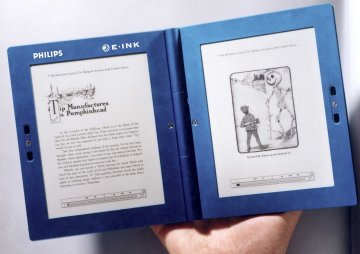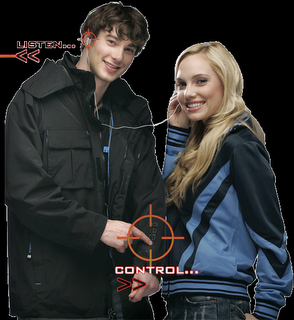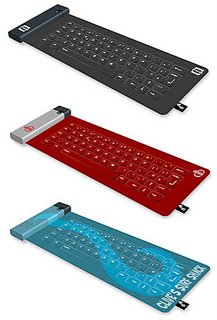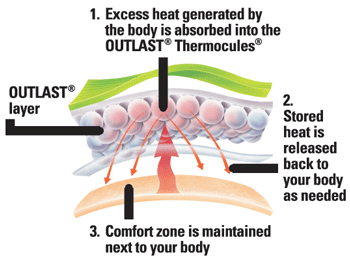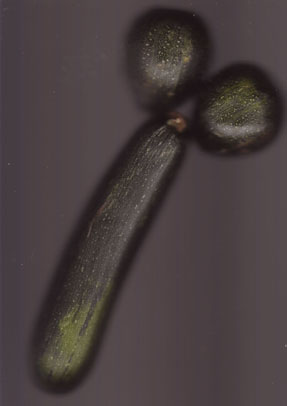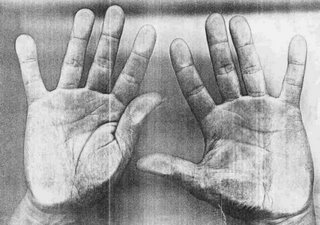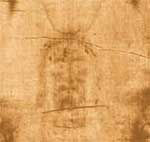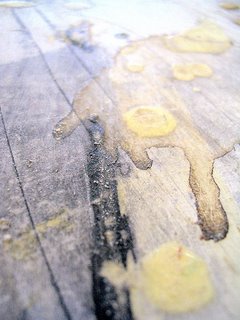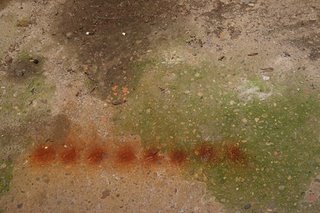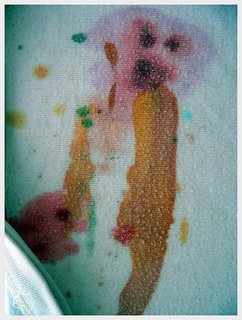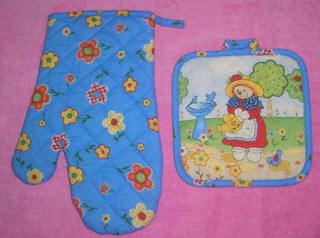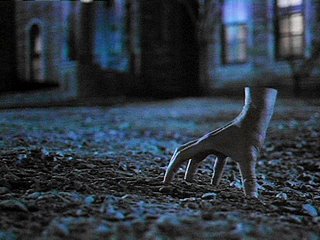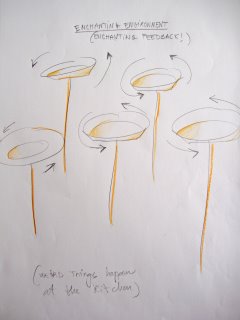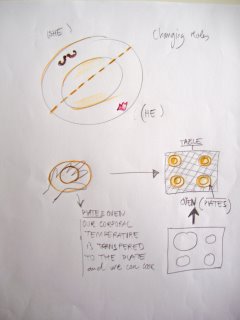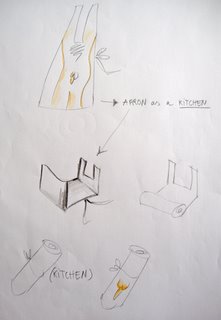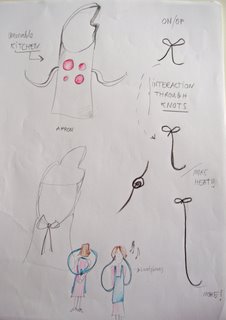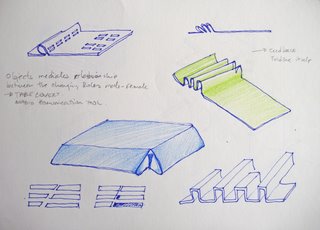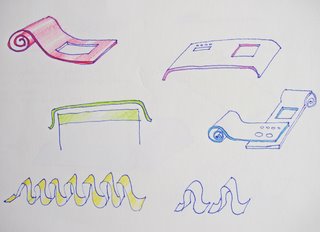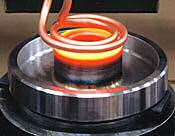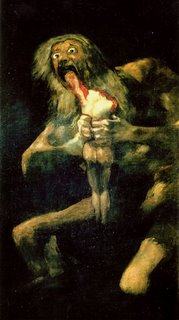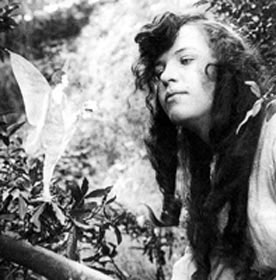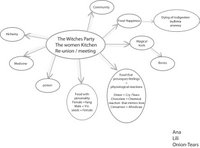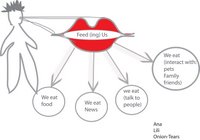Monday, May 08, 2006
Scottish institute develops new electronic paper display
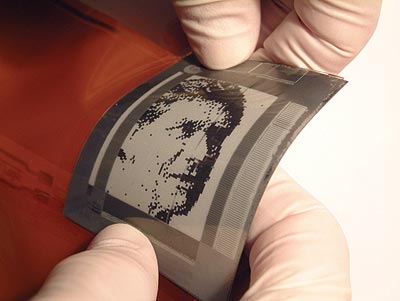
By Marcelo Duran
Associate Editor
Electronic paper is one step closer to becoming a reality, thanks to a team of Scottish scientists.
Researchers at the University of Paisley in Scotland developed a prototype plastic electronic display screen in partnership with DuPoint-Teijin Films and Plastic Logic.
Professor Frank Placido, director of the Thin Film Centre at the University of Paisley, said the production of a pixilated flexible display required the development and manufacture of the switching electronics - an active-matrix backplane - on a polymer, or organic, backing.
A readable electronic display equivalent in resolution to a high-quality magazine would be an attractive option for newspapers, experts say.
Photo: University of Paisley
“This is not a simple task, because conventional silicon-based electronics require processing temperatures that are too high for polymer sheets,” he said. “Hence, existing commercial displays are based on fragile glass substrates.”
Paisley’s prototype, by contrast, sports plastic transistors placed on a polymer surface.
Laminated
It’s then laminated to a display technology developed by E-Ink Corp. to produce “a working display,” Placido said.
The Polymer Vision display, introduced last year by E-Ink and Royal Philips, is an ultra-thin, large-area scrollable device that’s capable of letting consumers comfortably read text-intensive documents, according to the company (see Newspapers & Technology, March 2004).
Philips demonstrates intelligent displays
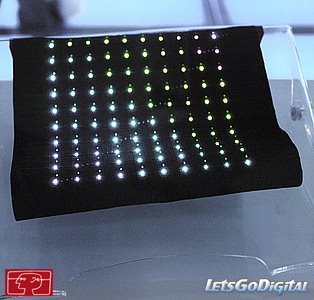
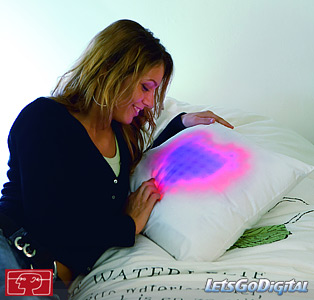
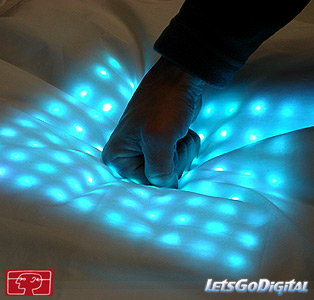
Philips demonstrates intelligent displays : At the IFA 2005, Philips is demonstrating photonic textiles; fabrics that contain lighting systems and can therefore serve as displays. With the development of this new and unusual technology, Philips Research is pointing the way toward a new age in the long history of textiles. At first glance, objects such as clothing, towels, upholstery, and drapes would seem unlikely places on which to place intelligent and interactive systems. Yet these low-tech objects figure prominently in our lives. By integrating flexible arrays of multicolored light-emitting diodes (LEDs) into fabrics, and doing so without compromising the softness of the cloth, Philips is bringing these inert objects to life.
Flexible and Drapable - To meet the challenge of creating light-emitting cloth objects that retain their softness, Philips Research and textile institute TITV Greiz have developed an interconnecting substrate made entirely of cloth. Researchers from Philips have also created flexible and drapable substrates from plastics and films. On these substrates, the researchers have placed passive matrices of compact RGB LED packages. The pixelated luminaires with relatively large distance between the RGB pixels have been embedded in such everyday objects as cushions, backpacks, and floor mats.
Photonic textiles Interactivity - Since the fabric material covering the miniature light sources naturally diffuses light, each pixel seems bigger than it actually is. The LEDs, therefore, remain small and unobtrusive, while the fabric retains its soft look and feel. Photonic textiles can also be made interactive. Philips has achieved interactivity by incorporating sensors (such as orientation and pressure sensors) and communication devices (such as Bluetooth, GSM) into the fabric.
IFA 2005 - Opportunity to get feedback - The results of these innovations are as various and promising as they are novel. Photonic textiles open up a wide range of applications in the fields of ambient lighting, communication, and personal health care. Photonic textiles are still a young business. Even at this early stage, however, Philips envisions partnerships with interior and apparel brands that see the potential of photonic textiles to revolutionize the very concept of fabric. The demonstration at IFA is also meant to show the opportunities offered by this technology and to gain customers' and visitors' feedback on these options.
Related link : Philips pocket eReader Readius
Related link : LetsGoDigital News Headlines
Intelligent fabric
UK : Now, intelligent fabric from Eleksen
8th November, 2004
Imagine sensor and switches being made from textiles, and Eleksen, financed in large part by Siemens Venture Capital has developed a technology that makes it possible.
The technology helps electronic components integrate into clothing or a teddy bear, reports the Siemens research magazine "Pictures of the Future". Sensors made from textiles can measure how hard they are pressed and also whether moisture is present. But that’s not all: The
"intelligent fabric" is flexible, and it can be sewn or washed.
Eleksen mainly manufactures a flexible keyboard for PDAs that can be rolled up. Their utility in hospitals is immense as these sensors in bed linen could detect whether patients are lying in bed. Another possibility is a cell phone that can be folded, or airplane seats with integrated control elements in the upholstery.
This intelligent fabric combines conductive fibers and conventional textile fibers.It consists of two external, electrically conductive nylon layers. Between these two layers is a layer of insulating material, into which are woven individual conductive fibers.
On the outer layers there is a low measuring voltage supplied by a battery. If the user exerts pressure on the outer layers - with a finger, for example - the voltage changes. The sensor detects this change and can thereby precisely determine the amount of pressure exerted and its position.
The thin sensor layers are capable of withstanding enormous strain - not even the weight of a car will damage them. A more sensitive application might be a doll that begins to cry if it’s pressed too hard and laughs when it is tickled. Eleksen is now working on weaving individual sensor threads into textiles. This would further reduce costs and open up an even broader range of applications.
8th November, 2004
Imagine sensor and switches being made from textiles, and Eleksen, financed in large part by Siemens Venture Capital has developed a technology that makes it possible.
The technology helps electronic components integrate into clothing or a teddy bear, reports the Siemens research magazine "Pictures of the Future". Sensors made from textiles can measure how hard they are pressed and also whether moisture is present. But that’s not all: The
"intelligent fabric" is flexible, and it can be sewn or washed.
Eleksen mainly manufactures a flexible keyboard for PDAs that can be rolled up. Their utility in hospitals is immense as these sensors in bed linen could detect whether patients are lying in bed. Another possibility is a cell phone that can be folded, or airplane seats with integrated control elements in the upholstery.
This intelligent fabric combines conductive fibers and conventional textile fibers.It consists of two external, electrically conductive nylon layers. Between these two layers is a layer of insulating material, into which are woven individual conductive fibers.
On the outer layers there is a low measuring voltage supplied by a battery. If the user exerts pressure on the outer layers - with a finger, for example - the voltage changes. The sensor detects this change and can thereby precisely determine the amount of pressure exerted and its position.
The thin sensor layers are capable of withstanding enormous strain - not even the weight of a car will damage them. A more sensitive application might be a doll that begins to cry if it’s pressed too hard and laughs when it is tickled. Eleksen is now working on weaving individual sensor threads into textiles. This would further reduce costs and open up an even broader range of applications.
Thursday, May 04, 2006
Tuesday, May 02, 2006
Apron = Delantal = In front of
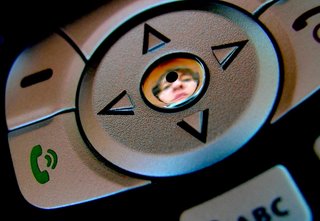
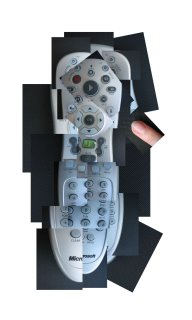
Space Vs object
Soft Vs Hard
Women “Vs” Men
We want our user to take out the kitchen when he need it and put it back as he pleases.
Object Vs Space
“Apron” = “delantal” = means In front off (concept)
“Apron” Is an “object that helps our user to read the domestic domain centred as an appliances + rituals + behaviours + habits.
anamorphosis
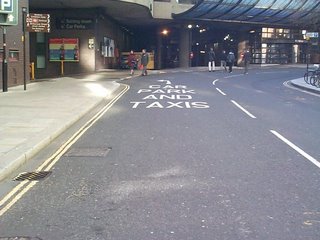
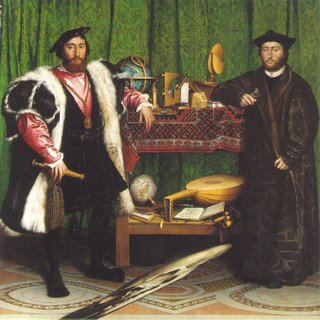
An unconventional way of seeing
An anamorphosis is a deformed image that appears in its true shape when viewed in some "unconventional" way. According to Webster's 1913 Dictionary:
A distorted or monstrous projection or representation of an image on a plane or curved surface, which, when viewed from a certain point, or as reflected from a curved mirror or through a polyhedron, appears regular and in proportion; a deformation of an image.
In one common form of anamorphosis---usually termed "oblique"--- the unconventionality arises from the fact that the image must be viewed from a position that is very far from the usual in-front and straight-ahead position from which we normally expect images to be looked at.
In another common form---sometimes termed "catoptric"---the image must be seen reflected in a distorting mirror (typical shapes being cylindrical, conical and pyramidal). The Hungarian artist István Orosz has produced some beautiful examples of these (e.g. Jules Verne, M. C. Escher)
You can download from this web site a piece of software called Anamorph Me! which will allow you to create your own oblique and catoptric anamorphoses.
The uses of anamorphosis:
Thursday, April 27, 2006
Wednesday, April 26, 2006
Gin and Tonic Fog – Marti Guixe 2006
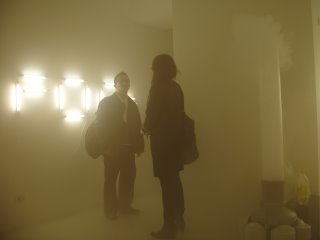
Enchanting environments
To cast a spell over; bewitch.
To attract and delight; entrance. See Synonyms at charm
Having the power to enchant; charming: enchanting music.
Charm
To attract or delight greatly: the simple elegance of the meal charmed the guests.
To induce by using strong personal attractiveness: charmed the guard into admitting them without invitations.
To cast or seem to cast a spell on; bewitch
